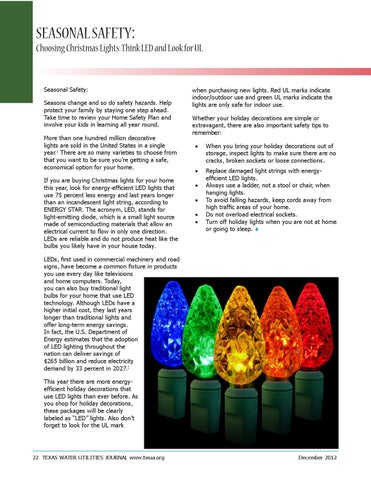SEASONAL SAFETY:
Choosing Christmas Lights: Think LED and Look for UL
Seasonal Safety: Seasons change and so do safety hazards. Help protect your family by staying one step ahead. Take time to review your Home Safety Plan and involve your kids in learning all year round. More than one hundred million decorative lights are sold in the United States in a single year.1 There are so many varieties to choose from that you want to be sure you’re getting a safe, economical option for your home. If you are buying Christmas lights for your home this year, look for energy-efficient LED lights that use 75 percent less energy and last years longer than an incandescent light string, according to ENERGY STAR. The acronym, LED, stands for light-emitting diode, which is a small light source made of semiconducting materials that allow an electrical current to flow in only one direction. LEDs are reliable and do not produce heat like the bulbs you likely have in your house today.
when purchasing new lights. Red UL marks indicate indoor/outdoor use and green UL marks indicate the lights are only safe for indoor use. Whether your holiday decorations are simple or extravagant, there are also important safety tips to remember: •
When you bring your holiday decorations out of storage, inspect lights to make sure there are no cracks, broken sockets or loose connections.
•
Replace damaged light strings with energyefficient LED lights. Always use a ladder, not a stool or chair, when hanging lights. To avoid falling hazards, keep cords away from high traffic areas of your home. Do not overload electrical sockets. Turn off holiday lights when you are not at home or going to sleep. S
• • • •
LEDs, first used in commercial machinery and road signs, have become a common fixture in products you use every day like televisions and home computers. Today, you can also buy traditional light bulbs for your home that use LED technology. Although LEDs have a higher initial cost, they last years longer than traditional lights and offer long-term energy savings. In fact, the U.S. Department of Energy estimates that the adoption of LED lighting throughout the nation can deliver savings of $265 billion and reduce electricity demand by 33 percent in 2027.2 This year there are more energyefficient holiday decorations that use LED lights than ever before. As you shop for holiday decorations, these packages will be clearly labeled as “LED” lights. Also don’t forget to look for the UL mark
22 TEXAS WATER UTILITIES JOURNAL www.twua.org
December 2012
